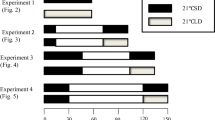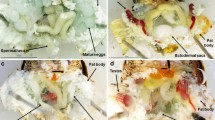Abstract
Overwintering females in the third generation of Pseudaulacaspis pentagona (Targioni Tozetti) (Hemiptera: Diaspididae) entered reproductive diapause with undeveloped ovarian eggs. Ovarian development in females collected before the winter solstice was retarded, but development proceeded normally thereafter. Neither length of photoperiod nor changing photoperiods affected the induction of reproductive diapause. Reproductive diapause of P. pentagona was induced when the temperature decreased to around 20 °C from the high temperature conditions of the previous generation spawning and current generation egg stages. A transfer test was conducted to elucidate temperature sensitivity, from 25 °C in the spawning and egg stages to 20 °C at various developmental stages. The sensitive stage for the induction of reproductive diapause was a few days after the emergence of females. Under natural conditions, first-generation eggs encounter temperatures below 20 °C in May and adults encounter the high temperatures in June to July and develop normally. Second-generation insects encounter temperatures of 24 °C or higher in July to August and develop normally as adults. In contrast, third-generation eggs encounter temperatures of 24 °C or higher in September and the adults encounter temperatures of 22 °C or lower in October, and reproductive diapause is induced. This paper will discuss the seasonal adaptations of P. pentagona in relation to regional climate conditions and the voltinism of two or three generations per year.




Similar content being viewed by others
References
Beardsley JW, Gonzalez RH (1975) The biology and ecology of armored scales. Ann Rev Entomol 20:47–73. https://doi.org/10.1146/annurev.en.20.010175.000403
Brown SW, Bennet FD (1957) On sex determination in the diaspine scale Pseudaulacaspis pentagona (Targ.) (Coccoidea). Genetics 42:510–523
Danks HV (1987) Insect dormancy: an ecological perspective. Biological Survey of Canada, Ottawa, p 439
Gotoh T, Kameyama Y (2014) Low temperature induces embryonic diapause in the spider mite, Eotetranychus smithi. J Insect Sci 14:1–8. https://doi.org/10.1093/jis/14.1.68
Hanks LM, Denno RF (1993) The white peach scale, Pseudaulacaspis pentagona (Targioni-Tozzetti) (Homoptera: Diaspididae): life history in Maryland, host plants, and natural enemies. Proc Entomol Soc Wash 95:79–98
Honda T, Koga R, Terai K, Morikawa R (2008) Verification of the model of predicting hatching timing of Pseudaulacaspis pentagona (Targioni) based on the Nagasaki mesh climatic data and survey of the insect natural enemies. Bull Nagasaki Agr & For Exp Stn 34:69–90 (in Japanese with English summary)
Kakimoto K, Tomihama T (2010) Effect of sprinkler-applied water spray on the control of Pseudaulacaspis pentagona (Targioni) in tea fields. Kyushu Plant Prot Res 56:88–91. https://doi.org/10.4241/kyubyochu.56.88 (in Japanese)
Kaneko S, Ozawa A, Saito T, Tatara A, Katayama H, Doi M (2006) Relationship between the seasonal prevalence of the predacious coccinellid Pseudoscymnus hareja (Coleoptera: Coccinellidae) and the mulberry scale Pseudaulacaspis pentagona (Hemiptera: Diaspididae) in tea fields : Monitoring using sticky traps. Appl Entomol Zool 41:621–626. https://doi.org/10.1303/aez.2006.621
Kawai A, Tatara A, Kouzaki Y (1997) The outbreak of mulberry scale, Pseudaulacaspis pentagona (Targioni), at tea fields in Japan in 1994 and 1995. Tea Res J 85:13–25 (in Japanese with English summary)
Lu Y, Zhao Q, Cheng L, Zhao L, Zhang H, Wei J (2020) The potential global distribution of the white peach scale Pseudaulacaspis pentagona (Targioni Tozzetti) under climate change. Forests 11(2):192. https://doi.org/10.3390/f11020192
Masaki S (2002) Ecophysiological consequences of variability in diapause intensity. Eur J Entomol 99:143–154. https://doi.org/10.14411/eje.2002.022
Okudai S, Korenaga R, Sakagami Y (1971) Studies on the autumnal appearance of larvae of the arrowhead scale, Unapsis yanoensis 1 Effect of temperature and diapause of the female adult on the autumnal appearance of larvae. Bull Hort Res Stn B 11:203–213 (in Japanese with English summary)
Ozawa A, Kubota S (2006) Verification of the method of predicting hatch timing of the white peach scale, Pseudaulacaspis pentagona (Targioni), by effective accumulative temperature. Bull Shizuoka Tea Exp Stn 25:23–31 (in Japanese with English summary)
Park JD, Kim KC (1990) Effects of temperature on development and distribution of mulberry scale, Pseudaulacaspis pentagona, within tree. Korean J Appl Entomol 29:238–243 (in Korean with English summary)
SAS Institute (2015) JMP, version 12.0.1. SAS Institute, Cary
Sato K (2007) Effect of high humidity and submerged conditions on hatchability of Pseudaulacaspis pentagona (Targioni-Tozetti) and a control method of high humidity conditions against eggs using a sprinkler spray in tea fields. Tea Res J 104:33–42. https://doi.org/10.5979/cha.2007.104.33 (in Japanese with English summary)
Shinano K, Terada T, Imanishi M (1976) On the factor of the frequency of generation of mulberry scale Pseudaulacaspis pentagona (Targioni) parasitic on tea plants. Bull Nara Expt Sta 7:47–52 (in Japanese with English summary)
Takano Y, Ullah MS, Gotoh T (2017) Effect of temperature on diapause termination and post-diapause development in Eotetranychus smithi (Acari: Tetranychidae). Exp Appl Acarol 73:353–363. https://doi.org/10.1007/s10493-017-0199-6
Takeda M (1998) Genetic basis of photoperiodic control of summer and winter diapause in geographic ecotypes of the rice stem maggot, Chlorops oryzae. Entomol Exp Appl 86:59–70. https://doi.org/10.1046/j.1570-7458.1998.00265.x
Takeda M (2004) Effects of temperature on oviposition in overwintering females and hatch in first-generation larvae of Pseudaulacaspis pentagona (Hemiptera: Diaspididae). Appl Entomol Zool 39:15–26. https://doi.org/10.1303/aez.2004.15
Takeda M (2006) Effect of temperature on the maintenance and termination of diapause in overwintering females of Pseudaulacaspis pentagona (Hemiptera: Diaspididae). Appl Entomol Zool 41:429–434. https://doi.org/10.1303/aez.2006.429
Takeda M, Nagata T (1992) Photoperiodic responses during larval development and diapause of two geographic ecotypes of the rice stem maggot, Chlorops oryzae. Entomol Exp Appl 63:273–281. https://doi.org/10.1111/j.1570-7458.1992.tb01584.x
Tauber MJ, Tauber CA, Masaki S (1986) Seasonal adaptations of insects. Oxford University Press, New York, p 411
Teshiba M, Imamura Y, Nabeya K, Fujitomi S (2019) Control effects of the pesticide buprofezin supplemented with paraffin on Pseudaulacaspis prunicola and Pseudaulacaspis pentagona. Kyushu Pl Prot Res 65:30–35. https://doi.org/10.4241/kyubyochu.65.30 (in Japanese with English summary)
Uchimura K, Kouzaki Y, Nakamura T (2006) Prediction of optimum timing of control against mulberry scale, Pseudaulacaspis pentagona (Targioni), using daily mean temperature. Bull Kagoshima Tea Exp Stn 18:1–8 (in Japanese with English summary)
Yasuda S (1981) Reproduction of Pseudaulacaspis pentagona Targioni (Hemiptera: Diaspididae). Jpn J Appl Entomol Zool 25:39–46. https://doi.org/10.1303/jjaez.25.39 (in Japanese with English summary)
Yoneyama S, Kamiya N (2003) Occurrence status and control measures in the bivoltine and trivoltine strains of the mulberry scale, Pseudaulacaspis pentagona (Targioni). Kongetsuno-Nougyou 11:30–33 (in Japanese)
Yoshioka T, Takeda M (2010) Effects of pesticides on Thomsonisca typica Mercet and Arrhenophagus chionaspidis Girault, parasitoids of Pseudaulacaspis pentagona (Targioni). Bull Fukuoka Agr Res Center 25:145–149 (in Japanese with English summary)
Zhuang QG, Hou TP, Hill MG (2016) Predicting white peach scale phenology on kiwifruit in Sichuan. N Z J Crop Hortic Sci 44:218–226. https://doi.org/10.1080/01140671.2016.1184692
Acknowledgements
I thank T. Mitsunaga for conducting the data analysis and for providing comments of this paper. I also thank S. Yoneyama, N. Kamiya, K. Sato and T. Mizuta for collecting local strains of P. pentagona. I would like to pay tribute to S. Kubota, who was the first to give a presentation on the induction of reproductive diapause in P. pentagona under diurnal temperature variation. I would like to thank the anonymous reviewers for providing me with their thoughtful comments on an earlier version of this manuscript.
Author information
Authors and Affiliations
Corresponding author
Additional information
Publisher's Note
Springer Nature remains neutral with regard to jurisdictional claims in published maps and institutional affiliations.
Rights and permissions
About this article
Cite this article
Takeda, M. Effect of changing temperatures from the spawning and egg stages to the emerging adult stage on the induction of reproductive diapause in females of Pseudaulacaspis pentagona (Hemiptera: Diaspididae). Appl Entomol Zool 57, 15–25 (2022). https://doi.org/10.1007/s13355-021-00757-3
Received:
Accepted:
Published:
Issue Date:
DOI: https://doi.org/10.1007/s13355-021-00757-3




